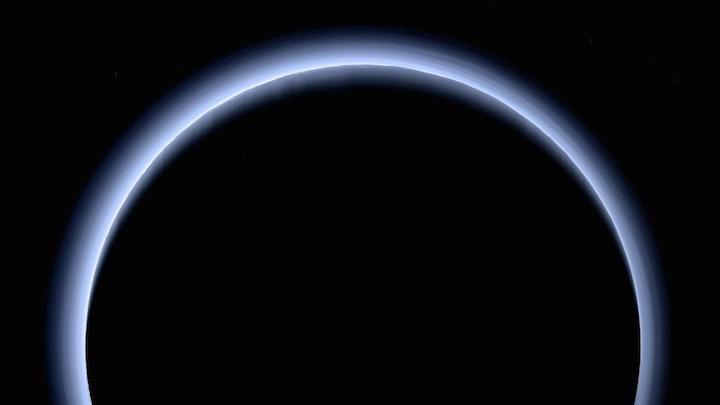16.05.2020

For many, the most spectacular image from the incredible high-speed New Horizons flyby of Pluto in July 2015 was this one (above) of the layers of blue haze in the dwarf planet’s atmosphere.
Now data from NASA’s “flying telescope” is explaining how Pluto’s haze is formed and how the distant Sun affects it from 3.7 billion miles away.

NASA's SOFIA "flying telescope" on a Boeing 747SP prepares for take-off.
NASAPublished this week in Icarus, the observations were made using NASA’s Stratospheric Observatory for Infrared Astronomy (SOFIA), a Boeing 747SP jetliner modified to carry a 106-inch diameter telescope, during a rare eclipse-like occultation of a star by Pluto.
-
It’s ‘Comet SWAN’ Week. Here’s How You Can See The ‘Comet Of The Year’
-
Coronavirus, Hurricanes Or Climate Change - Why The ‘Bad Things’ Get More Attention
-
The Original Plandemic: Unmasking The Eerily Familiar Conspiracy Theories Behind The Russian Flu Of 1889
“Pluto is a mysterious object that is constantly surprising us,” said Michael Person, the lead author of the paper and director of Massachusetts Institute of Technology’s Wallace Astrophysical Observatory. “There had been hints in earlier remote observations that there might be haze, but there wasn’t strong evidence to confirm it really existed until the data came from SOFIA.”

How SOFIA flew into Pluto's shadow to observe the light passing through its atmosphere.
NASA/SOFIA/USRA/ASP/L/PROUDFITChasing Pluto’s shadow
The celestial line-up between Pluto and a 12th-magnitude star in the constellation of Sagittarius cast a faint 1,430 miles-wide shadow that races across on Earth’s surface at 53,000 mph—taking just a few seconds—which SOFIA intercepted at 40,000 ft. over the Pacific Ocean near New Zealand.

Still image from an animation illustrating Pluto passing in front of a star during an eclipse-like ... [+] NASA
The occultation, which happened on June 30, 2015—just two weeks before New Horizons conducted its flyby of Pluto—allowed astronomers to measure the light of the star for 90 seconds as it streamed through Pluto’s atmosphere.
The key moment—a “central flash” a little like when totality begins during a total solar eclipse—held a wealth of data about Pluto’s atmosphere. The star is five times brighter than Pluto.

SOFIA’s flight path for June 29, 2015 indicating where the Pluto occultation observations were made.
NASA/SOFIA/L. PROUDFITHow it almost went wrong
Last minute predictions of exactly where the shadow would fall changed at the last minute. “Capturing that shadow required a bit of scramble,” said William Reach of Universities Space Research Association and SOFIA’s associate director for science operations. “There were a few tense moments, but the team worked together, and we got clearance. We reached Pluto’s shadow at exactly the right time and were very happy to have made it!”
Combined observations
The timing was key because SOFIA proved that not only can scientists monitor planetary bodies like Pluto in the many years between rare spacecraft flybys, but also the value of combined observations. SOFIA observed the middle layers of Pluto’s atmosphere in the infrared and visible light wavelengths, while New Horizons almost immediately got data on Pluto’s upper and lower layers using radio waves and ultraviolet light.
“Similar complementary capabilities of SOFIA in tandem with other ground-based and space-based astronomical observatories have been demonstrated and will continue to be explored in future,” said Margaret Meixner, USRA’s Director of SOFIA Mission Operations.
SOFIA has done something similar with Saturn’s largest moon, Titan, as detailed in a brilliant BBC podcast broadcast in 2019.
What is Pluto’s atmosphere like?
The combined observations is the most complete picture yet of Pluto’s thin hazy atmosphere, which astronomers think is a photochemical smog created by sunlight reacting with methane and other molecules in the dwarf planet’s atmosphere.
Pluto’s atmosphere is predominantly nitrogen gas, along with small amounts of methane and carbon monoxide. It’s created as surface ice vaporizes under the weak light of the Sun. The particles that make-up Pluto’s haze form from methane and other gases over 20 miles above the surface. They then return to the icy surface as snow.
What does the research reveal?
SOFIA’s observations discovered that the particles are extremely small, just 0.06-0.10 micron thick, or 1,000 times smaller than the width of a human hair. Because of their small size, they scatter blue light more than other colors as they drift toward the surface, creating the blue tint.
More importantly, the new paper suggests that Pluto’s haze is made of very small particles that hang about in the atmosphere for long periods rather than immediately falling to the surface, as had been assumed. SOFIA’s data also shows that these haze particles are actively being replenished.

Just 15 minutes after its closest approach to Pluto on July 14, 2015, NASA’s New Horizons spacecraft ... [+] NASA/JHUAPL/SWRI
On Pluto, winter is coming
That could have ramifications for what, exactly, is going to happen to Pluto when it moves into even colder areas of space. After all, one orbit of the Sun—a year on Pluto—takes 248 Earth years, and it had been thought that as the dwarf planet moved away from the Sun less surface ice would be vaporized. That, in turn, would mean fewer atmospheric gases while losses to space continued—eventually leading to atmospheric collapse.
However, this new work suggests that Pluto’s haze thickens and then fades in a cycle lasting just a few years, which indicates that the tiny particles are being created relatively quickly. “Now we’re questioning if Pluto’s atmosphere is going to collapse in the coming years,” said Person, whose work suggests that Pluto’s atmosphere appears to change on a shorter cyclical pattern. “It may be more resilient than we thought.”
Ultimately, it could be Pluto’s haze, not its distance from the Sun, that regulates its atmosphere.
“There’s still a lot we don’t understand, but we’re forced now to reconsider earlier predictions,” said Person. “Pluto’s atmosphere may collapse more slowly than previously predicted, or perhaps not at all. We have to keep monitoring it to find out.”
Wishing you clear skies and wide eyes.
Quelle: Forbes
